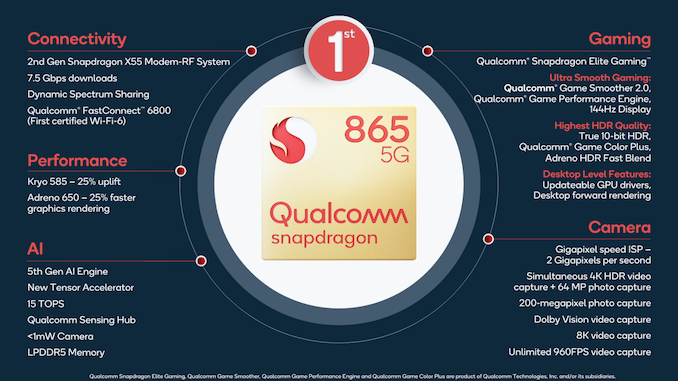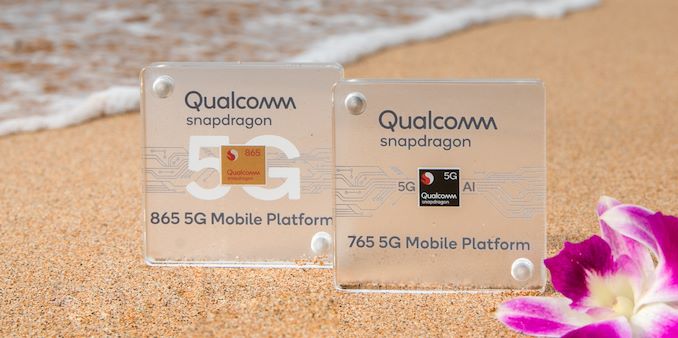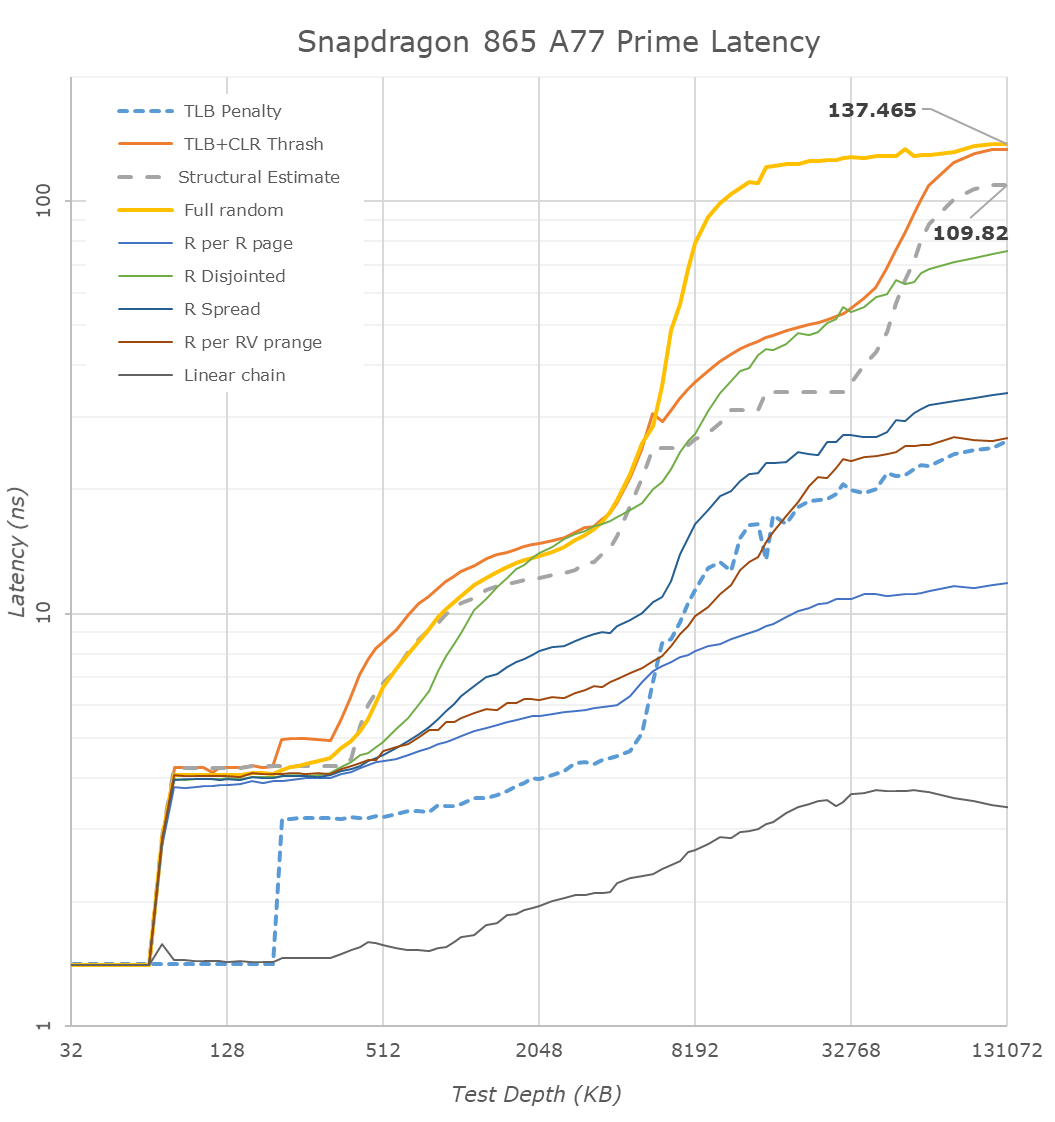The Snapdragon 865 Performance Preview: Setting the Stage for Flagship Android 2020
by Andrei Frumusanu on December 16, 2019 7:30 AM EST- Posted in
- Mobile
- Qualcomm
- Smartphones
- 5G
- Cortex A77
- Snapdragon 865

Earlier this month we had the pleasure to attend Qualcomm’s Maui launch event of the new Snapdragon 865 and 765 mobile platforms. The new chipsets promise to bring a lot of new upgrades in terms of performance and features, and undoubtedly will be the silicon upon which the vast majority of 2020 flagship devices will base their designs on. We’ve covered the new improvements and changes of the new chipset in our dedicated launch article, so be sure to read that piece if you’re not yet familiar with the Snapdragon 865.
As has seemingly become a tradition with Qualcomm, following the launch event we’ve been given the opportunity to have some hands-on time with the company’s reference devices, and had the chance to run the phones through our benchmark suite. The QRD865 is a reference phone made by Qualcomm and integrates the new flagship chip. The device offers insight into what we should be expecting from commercial devices in 2020, and today’s piece particularly focuses on the performance improvements of the new generation.
- Qualcomm Announces Snapdragon 865 and 765(G): 5G For All in 2020, All The Details
- Qualcomm Windows on Snapdragon: New 7c & 8c SoCs for sub-$800 Laptops
- Quick Bytes: Qualcomm’s Dynamic Spectrum Sharing Demo with 5G and 4G
- Quick Bytes: Qualcomm’s Prediction of 1.4 Billion 5G Smartphones by 2022
- Qualcomm Snapdragon Tech Summit Live Blog: Day One
- Qualcomm Snapdragon Tech Summit Live Blog Day Two: All About Mobile
- Qualcomm Snapdragon Tech Summit Day 3 Live Blog: ACPC and XR
A quick recap of the Snapdragon 865 if you haven’t read the more thorough examination of the changes:
| Qualcomm Snapdragon Flagship SoCs 2019-2020 | |||
| SoC |
Snapdragon 865 |
Snapdragon 855 | |
| CPU | 1x Cortex A77 @ 2.84GHz 1x512KB pL2 3x Cortex A77 @ 2.42GHz 3x256KB pL2 4x Cortex A55 @ 1.80GHz 4x128KB pL2 4MB sL3 @ ?MHz |
1x Kryo 485 Gold (A76 derivative) @ 2.84GHz 1x512KB pL2 3x Kryo 485 Gold (A76 derivative) @ 2.42GHz 3x256KB pL2 4x Kryo 485 Silver (A55 derivative) @ 1.80GHz 4x128KB pL2 2MB sL3 @ 1612MHz |
|
| GPU | Adreno 650 @ 587 MHz +25% perf +50% ALUs +50% pixel/clock +0% texels/clock |
Adreno 640 @ 585 MHz |
|
| DSP / NPU | Hexagon 698 15 TOPS AI (Total CPU+GPU+HVX+Tensor) |
Hexagon 690 7 TOPS AI (Total CPU+GPU+HVX+Tensor) |
|
| Memory Controller |
4x 16-bit CH @ 2133MHz LPDDR4X / 33.4GB/s or @ 2750MHz LPDDR5 / 44.0GB/s 3MB system level cache |
4x 16-bit CH @ 1866MHz LPDDR4X 29.9GB/s 3MB system level cache |
|
| ISP/Camera | Dual 14-bit Spectra 480 ISP 1x 200MP 64MP ZSL or 2x 25MP ZSL 4K video & 64MP burst capture |
Dual 14-bit Spectra 380 ISP 1x 192MP 1x 48MP ZSL or 2x 22MP ZSL |
|
| Encode/ Decode |
8K30 / 4K120 10-bit H.265 Dolby Vision, HDR10+, HDR10, HLG 720p960 infinite recording |
4K60 10-bit H.265 HDR10, HDR10+, HLG 720p480 |
|
| Integrated Modem | none (Paired with external X55 only) (LTE Category 24/22) DL = 2500 Mbps 7x20MHz CA, 1024-QAM UL = 316 Mbps 3x20MHz CA, 256-QAM (5G NR Sub-6 + mmWave) DL = 7000 Mbps UL = 3000 Mbps |
Snapdragon X24 LTE (Category 20) DL = 2000Mbps 7x20MHz CA, 256-QAM, 4x4 UL = 316Mbps 3x20MHz CA, 256-QAM |
|
| Mfc. Process | TSMC 7nm (N7P) |
TSMC 7nm (N7) |
|
The Snapdragon 865 is a successor to the Snapdragon 855 last year, and thus represents Qualcomm’s latest flagship chipset offering the newest IP and technologies. On the CPU side, Qualcomm has integrated Arm’s newest Cortex-A77 CPU cores, replacing the A76-based IP from last year. This year Qualcomm has decided against requesting any microarchitectural changes to the IP, so unlike the semi-custom Kryo 485 / A76-based CPUs which had some differing aspects to the design, the new A77 in the Snapdragon 865 represents the default IP configuration that Arm offers.
Clock frequencies and core cache configurations haven’t changed this year – there’s still a single “Prime” A77 CPU core with 512KB cache running at a higher 2.84GHz and three “Performance” or “Gold” cores with reduced 256KB caches at a lower 2.42GHz. The four little cores remain A55s, and also the same cache configuration as well as the 1.8GHz clock. The L3 cache of the CPU cluster has been doubled from 2 to 4MB. In general, Qualcomm’s advertised 25% performance uplift on the CPU side solely comes from the IPC increases of the new A77 cores.
The GPU this year features an updates Adreno 650 design which increases ALU and pixel rendering units by 50%. The end-result in terms of performance is a promised 25% upgrade – it’s likely that the company is running the new block at a lower frequency than what we’ve seen on the Snapdragon 855, although we won’t be able to confirm this until we have access to commercial devices early next year.
A big performance upgrade on the new chip is the quadrupling of the processing power of the new Tensor cores in the Hexagon 698. Qualcomm advertises 15 TOPS throughput for all computing blocks on the SoC and we estimate that the new Tensor cores roughly represent 10 TOPS out of that figure.
In general, the Snapdragon 865 promises to be a very versatile chip and comes with a lot of new improvements – particularly 5G connectivity and new camera capabilities are promised to be the key features of the new SoC. Today’s focus lies solely on the performance of the chip, so let’s move on to our first test results and analysis.
New Memory Controllers & LPDDR5: A Big Improvement
One of the larger changes in the SoC this generation was the integration of a new hybrid LPDDR5 and LPDDR4X memory controller. On the QRD865 device we’ve tested the chip was naturally equipped with the new LP5 standard. Qualcomm was actually downplaying the importance of LP5 itself: the new standard does bring higher memory speeds providing better bandwidth, however latency should be the same, and power efficiency benefits, while there, shouldn’t be overplayed. Nevertheless, Qualcomm did claim they focused more on improving their memory controllers, and this year we’re finally seeing the new chip address some of the weaknesses exhibited by the past two generations; memory latency.
We had criticised Qualcomm’s Snapdragon 845 and 855 for having quite bad memory latency – ever since the company had introduced their system level cache architecture to the designs, this aspect of the memory subsystem had seen some rather mediocre characteristics. There’s been a lot of arguments in regards to how much this actually affected performance, with Qualcomm themselves naturally downplaying the differences. Arm generally notes a 1% performance difference for each 5ns of latency to DRAM, if the differences are big, it can sum up to a noticeable difference.
Looking at the new Snapdragon 865, the first thing that pops up when comparing the two latency charts is the doubled L3 cache of the new chip. It’s to be noted that it does look that there’s still some sort of logical partitioning going on and 512KB of the cache may be dedicated to the little cores, as random-access latencies start going up at 1.5MB for the S855 and 3.5MB for the S865.
Further down in the deeper memory regions, we’re seeing some very big changes in latency. Qualcomm has been able to shave off around 35ns in the full random-access test, and we’re estimating that the structural latency of the chip now falls in at ~109ns – a 20ns improvements over its predecessor. While it’s a very good improvements in itself, it’s still a slightly behind the designs of HiSilicon, Apple and Samsung. So, while Qualcomm still is the last of the bunch in regards to its memory subsystem, it’s no longer trailing behind by such a large margin. Keep in mind the results of the Kirin 990 here as we go into more detailed analysis of memory-intensive workloads in SPEC on the next page.
Furthermore, what’s very interesting about Qualcomm’s results in the DRAM region is the behaviour of the TLB+CLR Trash test. This test is always hitting the same cache-line within a page across different, forcing a cache line replacement. The oddity here is that the Snapdragon 865 here behaves very differently to the 855, with the results showcasing a separate “step” in the results between 4MB and ~32MB. This result is more of an artefact of the test only hitting a single cache line per page rather than the chip actually having some sort of 32MB hidden cache. My theory is that Qualcomm has done some sort of optimisation to the cache-line replacement policy at the memory controller level, and instead the test hitting DRAM, it’s actually residing at on the SLC cache. It’s a very interesting result and so far, it’s the first and only chipset to exhibit such behaviour. If it’s indeed the SLC, the latency would fall in at around 25-35ns, with the non-uniform latency likely being a result of the four cache slices dedicated to the four memory controllers.
Overall, it looks like Qualcomm has made rather big changes to the memory subsystem this year, and we’re looking forward to see the impact on performance.













178 Comments
View All Comments
jospoortvliet - Monday, December 16, 2019 - link
The best snapdragon can barely keep up with the a11, as Andrei points out in his analysis. YouTube speed tests are by far the most useless and pointless benchmarks ever devised, which is why not a single reputable source (like anandtech) ever uses them...Sorry, but the only question here is how much faster the a14 will be. 40%, 50% or even more...
Kishoreshack - Monday, December 16, 2019 - link
Why doesn't Qualcomm simply increases their die size & use a larger die properly to at least come closer to applemaybe it is needs more than a larger die size
it needs a better Architecture
Arm or Qualcomm whom to blame?
eastcoast_pete - Monday, December 16, 2019 - link
A key problem for smartphones is power budget. These SoCs are already pushing 5 W/h and up if running at full tilt, so even a nicely sized battery (5000 mAh) can be drained in 3-4 hours top if someone runs them accordingly. Apple has managed to accommodate high peak/burst performance while still getting good overall power usage, and I still find their battery life wanting.Quantumz0d - Monday, December 16, 2019 - link
Why do they need to ? Apple is only Apple and it only works for them.If you see realworld speedtests on YouTube see how OP7 Pro flies through the tasks giving the user a faster and smoother experience.
And go to ScyllaDB website and see how AWS Graviton 2 stacks with Intel in Benches and how they mention benches only should not be taken as a measure.
Apple OS lacks Filesystem. It cannot be a computer ever. iOS is a kid friendly OS. You can't even fucking change launcher / icons forget other system level changes.
Qcomm needs competition from MediaTek, Exynos. Huawei HiSilicon but except Exynos all are garbage because they do not let us unlock Bootloaders. And Android phones see community driven ROMs there is so much or choice to add even the DAPs from 200USD to 3000USD have Qcomm technology.
Repairing is also easier due to the HW Boxes which can bring a QComm9008 Brick to life. Whereas with Apple its Ball and Chain ecosystem.
I see my SD835 run like butter through everything I throw at it and has an SD slot too.
This stupid Whiteknighting of Apple processors beating x86 and their use case / Android Phones is a big sham. People need to realize benches are not the only case when you compare Processors accross OSes.
jospoortvliet - Monday, December 16, 2019 - link
A 1995 computer running MS DOS 6.0 is also butter smooth, I hope you dont think that means an intel 486 DX4 is faster than an apple chip.Please stop with your nonsense about "real world tests". Real world your 835 has a slower cpu, GPU, and storage. Doesn't mean it is garbage - it is fine you are happy with it but it is not your duty to defend the honor of Oppo against facts. I dont want an iphone either die to their walked garden but that doesn't mean I live under the delusion that my brand new galaxy s10e is anything other than at least 40% slower and twice as inefficient as an iPhone 11...
cha0z_ - Friday, December 27, 2019 - link
Coming from exynos 9810 note 9 to iphone 11 pro max... the SOC on the iphone is literally times faster and more efficient than the exynos. The difference is absurdly big and people still calls apple slower because of design choices (like the slow animations, etc). It's super smooth in all conditions/times + it's rofl fast in any app/game (not to mention apps got functions not available on android). GL running full PC civilization 6 on android with decent performance later in the game on bigger map and decent battery life. There is a reason why the game was not ported on android too (and not only piracy) - it will run poor even on most high end current gen android phones.ksec - Monday, December 16, 2019 - link
They could, but are you going to pay for it? Let say Qualcomm has to bump up $50 ( inclusive of their profits ) to reach the same level of performance, as you consumer you will have to pay roughly $100 more.In a cut throat Android market, who is going to risk putting up their Smartphone price by $100?
There is a reason why Samsung and Huawei are trying to make SoC themselves, instead of putting those profits into Qualcomm's hand, they want those cost to go towards more die space to better differentiate their product and compete with Apple.
Now here is another question, how many consumer will notice the different in CPU speed? And how many consumer will notice the Modem quality different?
They are all set of trade offs, not only in engineering, but also in cost, markets, risk... etc...
jospoortvliet - Monday, December 16, 2019 - link
It is a matter of cost. Arm could design a cpu core that is 4 times the size of the a76 and 50% faster, catching up to apple. But that would cost a lot of die size and thus money... for high margin, high cost devices it is ok but not for cheap ones. Ape can afford this...jospoortvliet - Monday, December 16, 2019 - link
Ape - I mean apple of course!cha0z_ - Friday, December 27, 2019 - link
It's not that simple as putting a lot of transistors in it. You can somewhat tackle the problem with that, but by itself it will not lead to the desired end result.I can elaborate, but it will be lengthily and highly technical post.